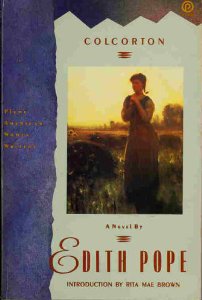(1992. Plume. ISBN 0-452-26324-7)
First off, don’t rely on the book jacket description of this forgotten work of literary prose from a now-forgotten author. There is indeed a family secret, as hinted in the blurbs on the novel’s back cover that weaves its way into this story of hardscrabble existence. But unlike the depiction of the revelation of that secret in the comments from the book’s rear cover, the mystery concealed deep within the history of the Clanghearne clan doesn’t reveal itself in the opening stages of this fine story: It unravels, as Abby Clanghearne’s life seems destined to, far into the tale, long after Jared Clanghearne, Abby’s brother, has met his untimely end.
That having been said, this is one of those period novels written by an author readers haven’t heard of that is truly a “must” read for a number of reasons.
First, Pope is a quality wordsmith. That alone should be enough to compel you to search out this long out of print piece of fiction. But more importantly, I have the deep suspicion that one of our most revered and beloved pieces of Southern writing, To Kill a Mockingbird, had at least a shove at its inception, from this story, Race does play a part in this tale, a significant one. Though unlike Harper Lee’s masterpiece, where the issue of privilege and social standing due to the color of a man’s skin is tackled head-on, Southern discrimination against those of black or mixed race seeps into Colcorton like swamp water leaking towards a stream. I have no proof, of course, that Ms. Lee read and was inspired by this novel. I have only the rankest of suspicion on my side that there’s a kinship between the two tales. But I stand by my observation. I’ll leave it to scholars of the two authors to settle the debate.
More importantly, Pope paints her characters, particularly the two female protagonists, Abby Clanghearne, the surviving matriarch of a nearly extinct and once proud clan, and her sister-in-law, Beth, Jared’s widow and the mother of the last Clanghearne (Jad, the heir to the decaying mansion, Colcorton, the centerpiece of the diminished family estate) with as fine a brush as a novelist can wield. Abby’s a rough and tumble creature reminiscent of the frontierswoman Ruby Thewes in the literary and commercial blockbuster, Cold Mountain. It may well be that the similarities between Abby and Ruby are coincidence. Or it may be that Charles Frazier, another writer with Southern sensibilities, read Pope’s work before he constructed Cold Mountain. One can never be positive of the influences relied upon, consciously or subconsciously, by writers. But if you’ve seen the film version of Frazier’s masterpiece and you read Colcorton, I guaranty you’ll envision talented actress Renee Zellweger, who played Ruby in the movie version of Cold Mountain, playing the part of Abby Clanghearne.
Pope’s use of the countryside; steamy, hot, wet, and full of danger real and imagined; is one of the most compelling reasons to read this book. The swamps and beaches and tidal marshes and wild creatures of the St. Augustine area come to life, much like the human characters in the story:
Staggering, she paused to watch an osprey drop through the sky like lead, his talons curving fiercely for the kill, his wings straight up like the wings of a sphinx. He hit the water with a smack and vanished in a plume of spray. Water flashed and fell from his pinions as the hawk beat his way upward, a fish moving in his claws. “Ay-ay,” Abby groaned in admiration. “Ain’t that a fine way to git your supper.
The land. It’s the land, as well as the family secret, that compels Abby Clanghearne to stay despite poverty, decay, and advancing age. And it is the land as depicted by Pope that forms as powerful a protagonist as Abby herself in the tale:
The sky grew pink in the east. She could tell where the ocean ended. The water no longer looked flat: she could see the scooped out shadows of the swells. Silvery beams of light ran up to the top of the sky. The sand began to sparkle. The sun came out of the ocean, burning red. The waves stopped purring; then the surf began to roar. The wind had sprung up.
Lord, to have the native or nurtured talent to write such a passage!
In many ways, this is a simple story in terms of the cast of characters who take the stage, the very parochial and condensed setting, and the moral and ethical issues that are raised by the Clanghearne family secret. And yet, as with Harper Lee’s better-known novel, there is complexity in the seemingly common and ordinary lives depicted in Colcorton. That alone makes this novel worth devouring.
Sadly, Edith Pope died fairly young and largely forgotten with but a modest body of work to her credit. There is no Wikipedia entry regarding her life or career and her obituary (http://news.google.com/newspapers?nid=888&dat=19610201&id=E-4NAAAAIBAJ&sjid=EHkDAAAAIBAJ&pg=5959,61347) reveals little about the writer as a person. The article chronicling her passing indicates that Mrs. Pope died of complications from a long illness (rheumatoid arthritis) in 1961 at the age of 53 after having created one work of note. Given how well Colcortan is constructed, perhaps that’s enough.
4 and ½ stars out of 5.
Note: This review first appeared on the Rural Lit R.A.L.L.Y. website, http://rurallitrally.org/. Log onto that website to learn more about this forgotten author. I’ve recently purchased a used copy of Pope’s historical novel, River in the Wind. I’ll let you know how that book reads in a bit…



